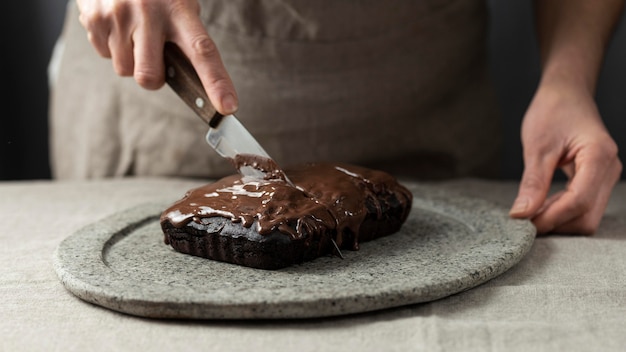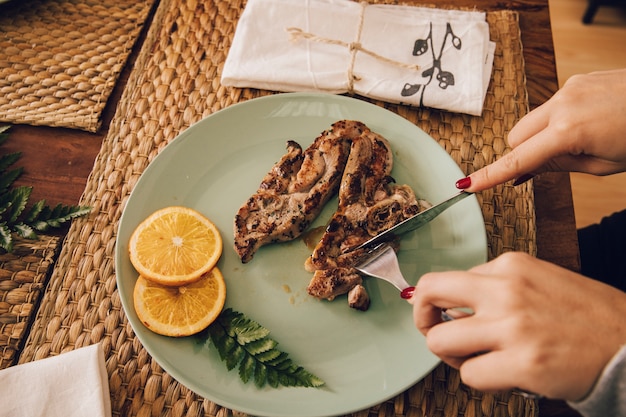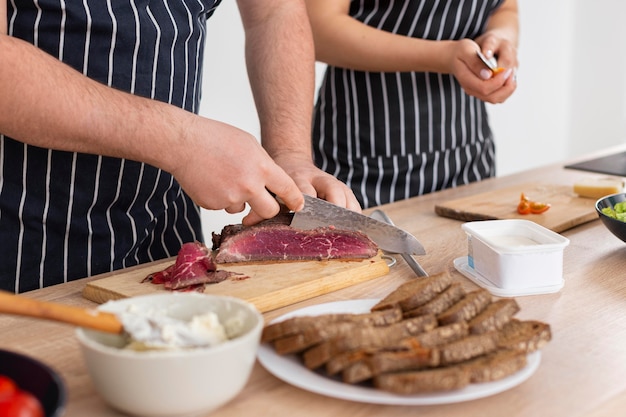(Part 1) The Journey to steak perfection: It's All About the Cut

First things first, you need to choose the right cut of steak. There are so many to choose from, it can be a bit overwhelming. For a classic medium-rare experience, my personal favourites are ribeye, sirloin, and fillet. They're all marbled with fat, which gives them that lovely flavour and tenderness.
Ribeye: The King of Steak?
Ribeye is a real crowd-pleaser. It's known for its rich flavour and beautiful marbling. The fat content makes it incredibly juicy and tender, and the flavour is truly divine. It's a bit more expensive than other cuts, but for a special occasion, it's absolutely worth it. It's also quite forgiving when it comes to cooking, so it's a good choice for beginners.
Sirloin: A Versatile Choice
Sirloin is another excellent choice for medium-rare. It's leaner than ribeye, but still has a good amount of flavour. It's a great option if you're looking for a steak that's a bit more budget-friendly, without sacrificing taste. The sirloin is a versatile cut, suitable for grilling, pan-searing, or even oven-roasting.
Fillet: The Delicate Delight
Fillet, also known as tenderloin, is the most tender cut of steak. It's incredibly buttery and melts in your mouth. Because it has very little fat, it can be a bit drier than other cuts, but when cooked correctly, it's pure indulgence. However, it can be a bit on the pricey side, and it's best for those who appreciate a more delicate and refined flavour.
Beyond the Classics: Exploring Other Cuts
But, don't limit yourself to just those three. You can get adventurous and try other cuts like flank steak, skirt steak, or even a nice piece of rump. Each cut has its own unique flavour and texture, and it's part of the fun to explore! Flank steak is known for its robust flavour and is often used in fajitas. Skirt steak, with its rich flavour and tender texture, is perfect for grilling. Rump steak, a more budget-friendly option, can be surprisingly tender when cooked properly.
(Part 2) Thickness Matters: A Key Factor for cooking time

The thickness of your steak is also going to determine how long it needs to cook. A thin steak will cook much faster than a thick one, so you need to keep that in mind. If you're cooking a thicker steak, you'll want to use a lower heat so it cooks evenly throughout. You want to avoid searing the outside while leaving the inside raw. It's all about finding that balance, you know?
Thickness and Temperature Relationship
Let me illustrate with an example. Imagine you're cooking a 1-inch thick steak and a 2-inch thick steak on a hot grill. The thinner steak will cook much faster, reaching the desired temperature for medium-rare in just a few minutes. But the thicker steak will take longer, and if you keep the heat high, the outside might burn before the inside is cooked through. This is why adjusting the heat based on the thickness of your steak is so important.
(Part 3) Temperature is King: Understanding the Thermometer

You can't rely on just visual cues to judge the doneness of your steak. I know some people say they can tell by looking at it, but I always prefer to be on the safe side and use a meat thermometer. It takes the guesswork out of cooking and ensures your steak is cooked to perfection.
The Magic Number for Medium-Rare
For medium-rare, you want the internal temperature of your steak to reach 130-135°F (54-57°C). It's that sweet spot between a pink center and a slightly cooked exterior. You want the steak to be tender and juicy, with a slight resistance when you cut into it. A thermometer allows you to achieve this consistency every time.
(Part 4) Cooking Methods: Finding Your Ideal Technique
There are a few different methods you can use to cook steak, and each one has its own advantages.
Pan-Searing: A Quick and Easy Option
Pan-searing is a great option for weeknight dinners. You simply heat up a pan over high heat, add a little bit of oil, and sear the steak for a few minutes on each side. This creates a beautiful crust on the outside while keeping the inside nice and juicy. The high heat helps to create those delicious sear marks, and the short cooking time makes it perfect for busy weeknights.
Grilling: That Smoky Flavour
If you've got a grill, you can't go wrong with grilling your steak. The smoky flavour adds a whole new dimension to your dish. I find charcoal grilling gives that extra smoky flavour, but gas grills are easier to control temperature-wise. Grilling allows for even cooking and creates those beautiful grill marks, which add both visual appeal and flavour.
Oven-Roasting: A Consistent Cook
Oven-roasting is a great option if you want to cook multiple steaks at once. It allows you to cook them evenly and at a consistent temperature. Plus, you can roast vegetables alongside your steak for a complete meal. Oven-roasting is a good choice if you want to cook several steaks to perfection at the same time, and it's also a great method for cooking larger cuts of meat.
(Part 5) Time is of the Essence: Calculating the Cooking Time
So, how long do you actually cook a steak for? Well, that depends on a few things: the thickness of your steak, the cooking method, and the temperature of your pan or grill. But, here's a general guide you can follow:
| Steak Thickness | Pan-Seared | Grilled | Oven-Roasted |
|---|---|---|---|
| 1 inch (2.5 cm) | 3-4 minutes per side | 4-5 minutes per side | 10-12 minutes |
| 1.5 inches (3.8 cm) | 4-5 minutes per side | 5-6 minutes per side | 15-18 minutes |
| 2 inches (5 cm) | 5-6 minutes per side | 6-7 minutes per side | 20-25 minutes |
Remember, these are just general guidelines. The actual cooking time will vary depending on your specific steak and your cooking preferences. It's always a good idea to check the internal temperature with a meat thermometer to ensure it's cooked to your liking. The key is to understand these guidelines, but don't be afraid to adjust them based on your own experience and the specific steak you are cooking.
(Part 6) The Resting Ritual: Let the Steak Relax
Once your steak is cooked, don't cut into it right away! Give it a good 5-10 minutes to rest. This allows the juices to redistribute, ensuring a more tender and flavourful steak. Trust me on this one, it makes a big difference.
Foiling it Up for Juicy Results
While resting, I like to wrap the steak in foil to keep it warm and prevent it from drying out. This helps to lock in all those delicious juices. The foil creates a mini-steam bath, keeping the steak moist and preventing it from losing its precious juices.
(Part 7) Mastering the Seasoning: Simple Yet Essential
Now, let's talk about seasoning. Don't overcomplicate things. Salt and pepper are your best friends when it comes to steak. Season generously before cooking.
The Importance of Salt
Salt is essential for flavour, but it also plays a key role in tenderizing the steak. When you salt the steak before cooking, the salt draws out some of the moisture, which then evaporates during cooking, leaving a more concentrated flavour. It also helps to create a nice crust on the outside of the steak.
Beyond Salt and Pepper: Experimenting with Flavour
Of course, if you want to add a bit more flair, you can try other seasonings like garlic powder, onion powder, or paprika. A little bit of fresh rosemary or thyme can also add a nice touch. Just don't go overboard, remember to let the flavour of the steak shine through. You can also experiment with different combinations of herbs and spices to create your own unique flavour profile.
(Part 8) Serving Your Steak: The Grand Finale
And finally, it's time to serve your steak. There are so many delicious ways to do this. You can simply serve it with a side of mashed potatoes, roasted vegetables, or a salad. Or you can get a bit fancier with a rich mushroom sauce or a creamy béarnaise sauce.
The Ultimate Steak Experience: A Complete Meal
For a real treat, why not create a full steak dinner? You can start with a delicious salad, then follow it up with your perfectly cooked steak and a selection of sides. Finish it off with a decadent dessert for the perfect ending. There's something truly satisfying about a complete meal, and a steak dinner is the perfect way to impress your guests.
(Part 9) FAQs: Answering Your Steak Questions
Now, let's address some of the most common questions about cooking steak:
1. What is the best way to cook a steak?
It really depends on your preference. I love pan-searing for its simplicity and quick cooking time. If you have a grill, you can't beat that smoky flavour. But, oven-roasting is perfect for cooking multiple steaks at once. Ultimately, find the method that works best for you and your kitchen. Try different methods to find your favourite, and don't be afraid to experiment!
2. Should I use a meat thermometer?
Absolutely! A meat thermometer is essential for ensuring your steak is cooked to your liking. It takes the guesswork out of cooking and helps you avoid overcooking. The thermometer is your best friend in the kitchen, ensuring that your steak is cooked perfectly every time.
3. How long should I rest my steak?
Give your steak a good 5-10 minutes to rest before cutting into it. This allows the juices to redistribute and results in a more tender and flavourful steak. This simple step makes a huge difference in the tenderness and juiciness of your steak.
4. How do I prevent my steak from being tough?
The key is to cook your steak to the right temperature. Overcooking is the main culprit for tough steak. Use a meat thermometer to ensure you cook it to your desired doneness. Understanding the internal temperature of your steak is crucial for avoiding overcooked, tough meat.
5. What are some good sides to serve with steak?
There are endless possibilities! Some of my personal favourites include mashed potatoes, roasted vegetables, salad, asparagus, and sauteed mushrooms. You can also go for more adventurous options like creamy polenta or a vibrant chimichurri sauce. The beauty of steak is that it pairs well with so many different side dishes, allowing you to create a diverse and satisfying meal.
(Part 10) The Final Word: Embracing Your Steak Journey
There you have it, a complete guide to cooking steak to perfection. It's not as complicated as it may seem. It's all about understanding the basics, choosing the right cut, and mastering the cooking time and temperature. So, go forth and conquer the steak! Experiment with different cuts, techniques, and seasonings to find your own personal steak favourites.
And remember, the most important thing is to enjoy the process. Cooking should be fun, and a delicious steak is a great way to celebrate. Whether you're grilling, pan-searing, or roasting, remember to relax, enjoy the process, and savour the delicious results.
Everyone is watching

Corn on the Cob: The Ultimate Guide to Perfectly Cooked Ears
Healthy MealsAh, corn on the cob. Just the name evokes images of sunny days, barbecues, and that sweet, juicy flavour that ...

Perfect Pork Roast Oven Cooking Time: A Guide to Delicious Results
Healthy MealsThere's something truly satisfying about a perfectly roasted pork. The aroma alone is enough to make your mout...

Ham Cooking Time: How Long to Bake, Smoke, or Boil a Delicious Ham
Healthy MealsAh, ham. It's a classic, isn't it? A real crowd-pleaser, especially around holidays. And when done right, it'...

Scallops: The Ultimate Guide to Perfect Cooking
Healthy MealsAh, scallops. Those delicate, sweet, and utterly delicious morsels of the sea. They hold a special place in my...

Spaghetti Squash: The Ultimate Guide to Cooking and Serving
Healthy MealsRemember that time you saw spaghetti squash at the supermarket, looking all bumpy and strange, and thought, "W...
